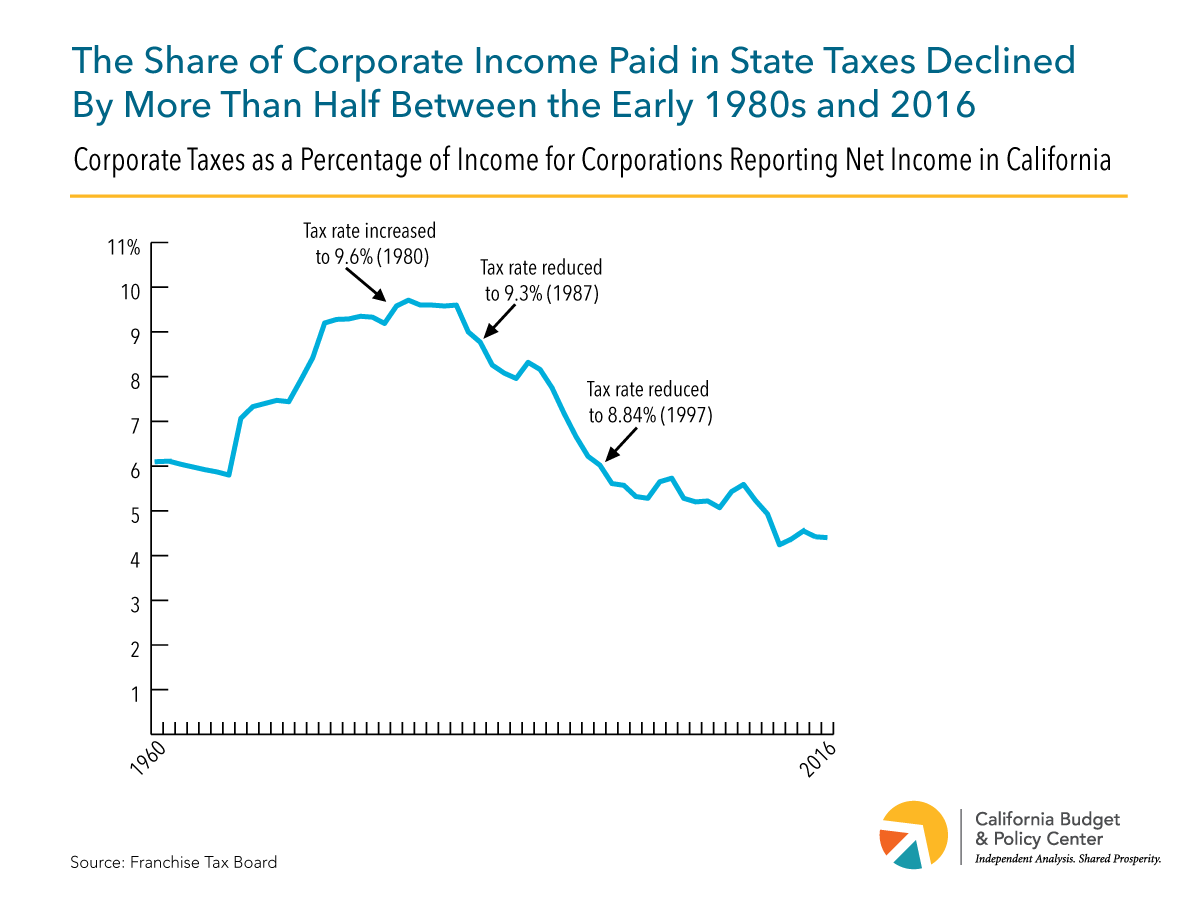by Jonathan Kaplan
In late 2017, President Trump signed the Tax Cuts and Jobs Act (TCJA) providing corporations substantial cuts in tax rates and other tax breaks. The TCJA means corporations will pay substantially less in federal taxes at a time when they already contribute far less of their California income in state taxes than they did a generation ago.
During the past three decades, the share of California corporate income paid in state taxes declined by more than half. In the early 1980s, corporations that reported profits in California paid more than 9.5% of this income in state corporate income taxes. In contrast, corporations paid just 4.4% of their California profits in income taxes in 2016, the most recent year for which data are available. California’s state budget would have received $10.9 billion more revenue in 2016 had corporations paid the same share of their income in taxes that year as they did in 1981. This amount is more than the state spends on the University of California, the California State University, and student aid combined.
The reduction of tax rates is one reason corporations pay less of their income in taxes today than they did in the 1980s. Since increasing the corporate tax rate to 9.6% in 1980, the state legislature has cut the rate twice: from 9.6% to 9.3% in 1987 and from 9.3% to 8.84%, its current level, in 1997.
In addition to cutting tax rates since the 1980s, lawmakers have enacted a number of corporate tax breaks that reduce the share of income that California corporations pay in state taxes. For example, beginning in 1987, California allowed multinational corporations to lower their tax liability by calculating their California income based on either their total income from worldwide operations or only from their operations within the US. This so-called “water’s edge” provision will cost the state an estimated $2.2 billion in 2018-19. In total, California is projected to spend $6.6 billion on tax expenditures for corporations in 2018-19, more than it will spend this year ($6.2 billion) on the state’s 115 community colleges.
At the national level, last year’s TCJA made several changes to federal tax law that will benefit corporations. The most significant change was slashing the federal corporate income tax rate from 35% to 21%, the largest one-time reduction to this tax rate in US history. Moreover, because the new federal tax law still includes many corporate tax breaks, including the ability to deduct state and local income taxes, the effective federal tax rate for corporations will often be lower than 21%. As a result, California corporations are likely to pay far less of their income in federal taxes beginning in 2018 than they have in recent years.
As the new Governor crafts a policy agenda that may require additional state resources, policymakers should consider the fact that corporations pay far less of their income in state taxes than they have in the past. And now that corporations are likely to pay less of their income in federal taxes as well, they can afford to contribute more to support the state’s public systems and supports. Increasing the state’s corporate income tax rate may be one way to boost revenue. However, policymakers have other options for increasing the amount corporations pay in state taxes. For example, they could review existing corporate tax rules, such as corporate tax credits, exemptions, and deductions, and reduce or eliminate those that are not achieving the state’s policy goals, including limiting state tax breaks in accordance with the new federal tax law. By reducing spending on corporate tax breaks, the state would have more resources available to invest in systems and programs such as higher education and workforce development that would not only help improve the lives of Californians, but also boost the state’s economy and produce an educated workforce that would benefit the state’s employers, including major corporations.
Published by the California Budget & Policy Center



 (909) 335-8100 ·
(909) 335-8100 ·  (909) 335-6777
(909) 335-6777 Email:
Email: